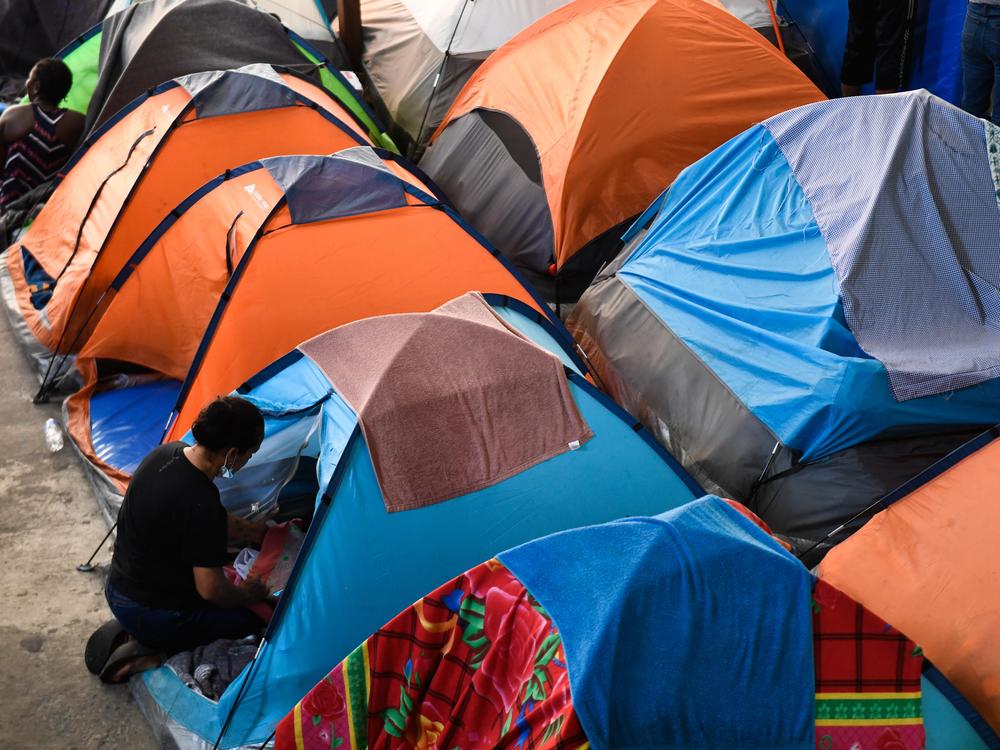Section Branding
Header Content
Trump reinforces use of his 'Remain in Mexico' policy
Primary Content
President Trump is bringing back enforcement of a policy that would require some asylum seekers at the southern border to wait in Mexico for their hearings in U.S. immigration court.
The policy, which was created and implemented during the first Trump administration in 2019, resulted in tens of thousands of migrants waiting for extended periods in Mexico. Known formally as the Migrant Protection Protocol, it was criticized for pushing migrants into squalid camps and leaving them vulnerable to pressure from drug cartels in the border region.
The move is among several orders aimed at increasing border security and disincentivizing migration to the United States. Since the early days of his 2024 presidential campaign, Trump has vowed to sign executive actions to impose severe limits on immigration to kick off his second term. During his campaign, Trump repeatedly vowed to bring back this asylum limiting policy.
"No matter what obstacles and dangers are thrown in our path, I will keep on fighting for you and for this country that we all love," Trump said in a September rally in Wisconsin, listing off several of his other proposals including reinstituting remain in Mexico.
The policy received renewed attention in Washington even before Trump was sworn into office. The Senate Homeland Security Committee's first hearing of the year was focused on remain in Mexico.
During the hearing, Democrats criticized the policy as a driver of criminal and cartel-related activity. Republicans argued the program curbed migration levels and should be brought back.
Advocacy groups, such as the American Civil Liberties Union, have vowed once again to challenge this and other immigration orders in court.
"These policies do not offer any solutions to improve border processing or address asylum and immigration court backlogs and are not an effective way to improve our immigration court system or address real needs at the border," the ACLU said in a statement ahead of last week's hearing.
CBP app also likely targeted
The CPB One app, which allowed migrants to schedule appointments at ports of entry along the U.S.-Mexico border, is no longer operational, according to a notice from Customs and Border Protection (CPB).
"Effective January 20, 2025, the functionalities of CBP One that previously allowed undocumented aliens to submit advance information and schedule appointments at eight southwest border ports of entry is no longer available, and existing appointments have been cancelled," a notice on the website updated on Monday reads.
Under the Biden administration, asylum seekers relied on the CBP One app developed by the CPB in order for them to make protection claims. The app was also used to submit records and information. It was a key part of the Biden administration's border management strategy to restore order and expand a pathway to legal entry.
The Biden administration said the CBP One app helped reduce crossings by migrants without legal status and made the border less chaotic. But immigration advocates compared it to Trump's "remain in Mexico," policy, which forced asylum seekers to wait in dangerous Mexican border cities for indefinite periods of time.
Critics of the app have maintained that it gave priority to newcomers instead of focusing on expediting pathways to legalization for immigrants who have lived in the U.S. for years. Republicans also argued the app created what was essentially a "catch and release" system, in which migrants are allowed into the U.S. while awaiting immigration proceedings. They also claimed the app's vetting systems are not strong enough to prevent fraud. There is no evidence of widespread fraud.
An estimated 1 million migrants have used it.
There are more requests than the app can accommodate. Wait times for an appointment via CBP One were months long at the time the app stopped working. NPR reporters have spoken to people who have been waiting at the border for an appointment for as long as nine months.
Legal battles stalled the policy
The remain in Mexico policy was caught in legal battles for much of the Biden administration. On his first day in office, Biden revoked the policy, which kicked off lawsuits from Texas and Missouri. The states argued the U.S. lacked adequate detention facilities to house all the migrants that were crossing the border. A Texas judge ordered that remain in Mexico be brought back by the administration — though Biden enforced it at a smaller scale.
The Biden administration eventually filed an appeal up to the U.S. Supreme Court where they found some success. The Supreme Court ruled in 2022 on a 5-4 decision that Biden did have the authority to end the policy.
But the Supreme Court sent back the case to the lower courts to decide if Biden's action was "arbitrary and capricious." A Trump-appointed Texas judge ruled that in the administration's memo on the ending policy, it failed to consider "key benefits." Still, he did not order the policy to be reinstated.
During his time in office, Biden implemented his own policies to limit asylum claims. Last summer, he issued an executive order that would allow the processing of most asylum claims to be suspended when the seven-day average of unauthorized crossings breached 2,500 people. The final rule was stricter. It mandated the suspension of asylum claims from those who cross between legal ports of entry when the seven-day average is 1,500 crossings.

